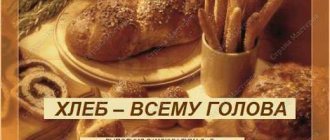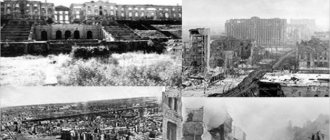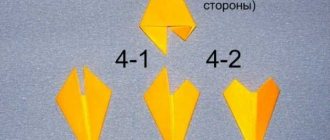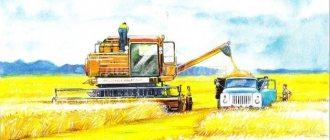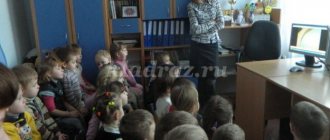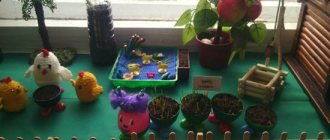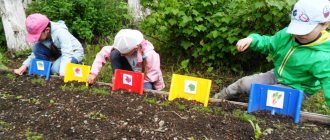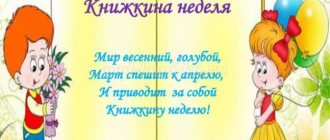Lesson on the topic “Bread is the head of everything”
Educator:
Do you want me to tell you how it got into the store?
Educator:
Flour is obtained from grains. But in order to obtain flour from grains, you need to spend a lot of labor and effort: first grow rye and wheat, then harvest. This is what grain growers do. Guys, do you want to know what kind of work this is?
Children:
Yes we want.
Educator:
Strong machines help people grow and harvest bread. In the spring, as soon as the ground thaws and dries out, a tractor comes out into the field to plow the ground. And so the earth became soft, docile and loose. Now you can start sowing! Seeders are attached to the tractor and they place wheat grains into the soil in even, neat rows. (slides 1,2)
The wheat has sprouted. All summer the grains ripen in the ears. The field is very beautiful at this time. (slide 3)
Let us also turn into grains that were sown in the field.
Physical school
A grain fell into the ground, (squat down) It began to sprout in the sun (hands above your head) The rain watered the ground, And the sprout grew (slowly stand up) It reached out to the light and warmth And turned into a handsome man. (2 times)
Educator:
Well, the grains are ripe. The harvest begins - this is the harvesting of the ears. (Children repeat the word in chorus and individually). Other machines enter the field - combines. Who works on the combine?
Children:
Combiner.
Educator:
What does a combine do? (slide 4)
Children:
Collects ears of corn.
Educator:
Combine - cuts the ears and threshes grains from them; these grains are poured through a special long sleeve into trucks, which constantly drive up at the signal of the combine operator. And large yellow shocks of threshed straw come out of the combiner's straw storage tank at certain intervals. Next, the cars transport the grain to elevators (Children repeat the word in chorus and individually) - special structures for storing grain. (slide 5) Where do you think grain is transported from elevators?
Children:
To the mill. (slide 6.7)
Educator:
That's right, and there the grain is ground into flour. Guys, where does the flour go then?
Children:
To a bakery, bakery. (slide 
Educator:
Right. At the bakery there are huge vats of sourdough. Flour, salt, sugar, water, yeast are added to the vat with the starter, and special machines use mechanical “hands” to knead the bread dough. And now the dough is kneaded and it’s time to put it in the mold and put it in the oven. And bakers bake it.
Educator:
Guys, listen to the poem:
Three boys along the alley, playing football as if, kicked a bun back and forth and scored a goal with it. An unfamiliar uncle walked past, stopped and sighed. And almost without looking at the guys, he extended his hand to that bun. “Who are you?” the children asked, forgetting about football for a while. “I’m a baker!” the man answered and slowly left with the bun. Educator:
Do you think the children behaved well? What was wrong with their behavior? How can you call their action? Why did the man pick up the bread? Do you think the children realized that they did the wrong thing by playing with bread like a soccer ball? Do we need to explain to them the importance of bread in human life? But during the war, many people died of hunger, without even a stale crust of bread. Therefore, bread should be treasured.
PASSPORT of the mini-museum “Bread is the head of everything”
Transcript
1 Municipal budgetary preschool educational institution "Kindergarten 182" of a general developmental type (MBDOU "Kindergarten 182") PASSPORT of the mini-museum "Bread is the head of everything" Developed by: M.V. Shcheglova O.I. Ganova, teachers Barnaul
2 Information about the work of the mini-museum Location of the mini-museum: MBDOU "Kindergarten 182", group "Watercolors" 13 Name of the mini-museum: "Bread is the head of everyone" Profile of the mini-museum: educational Direction: spiritual and moral education of preschoolers Year of opening: Head: M.V. Shcheglova, O.I. Ganova, educators Contents and exhibits: museum exhibits are collected in accordance with the age of the children, located on the shelves of the wall in the group room (exhibits related to the making of bread, literature on the topic (riddles, poems and original works about bread, which can be used directly educational activities, as well as in independent play activities of children), albums, sheaves of wheat ears, cereals, flour, postcards, children's drawings, applications, photographs). The exhibits of the mini-museum are freely available to children and are used by them for role-playing games and theatrical activities. The exhibits can be used in the process of direct educational activities, specifically in the educational areas “Cognitive”, “Socially”, “Artistic Aesthetic Creativity”. Games and game paraphernalia are located on a low shelf. Children can use them independently in the process of independent play activities or together with a teacher in the process of direct educational activities. Using a mini museum: - conducting excursions - conversations - didactic games - reading fiction, memorizing poems about bread - speech creativity (inventing riddles, fairy tales) - modeling from salt dough. Forms of activity: — search; - stock; — scientific; — expositional; - educational.
3 Explanatory note Recently, the organization of work with children on the basis of mini-museums created in preschool educational institutions has become widespread. Appeal to history, mastering the social experience of past generations, immersion in the world of national culture with the help of museum exhibits allows the child to gain an understanding of traditions, form a holistic picture of the world, stimulate interest in search and research activities, learn about the elements of material and spiritual culture, contribute to the formation of historical consciousness. There are concepts in the world whose value cannot be measured in anything. This is air, earth, water, sun. These include bread, an ancient and ever-young product of human labor. “Bread is the head of everything,” says popular wisdom. Not a single modest breakfast, everyday lunch, or holiday table is complete without bread. Growing up, children remember the smell of their home all their lives and subsequently, when they create their own families, they intuitively keep in them the same traditions that they absorbed in their parental home. After all, bread accompanies us from birth to old age - our good friend, whose name in all languages people pronounce with love and warmth. How to teach respect for bread? Our mini museum of bread is about bread and our attitude towards it. Bread in Altai is loved, proud and glorified. But, unfortunately, observations and conversations have shown that preschool children have insufficiently formed ideas about the culture of bread consumption and its importance for human health. A child can throw away bread; children themselves do not need to use leftover bread to keep birds in the winter. Reflections on the attitude of children to bread prompted the creation of a mini museum in the group, “Bread is the Head of Everything.” Goal: implementation of the direction “Museum pedagogy”. Creating conditions for the development of cognitive and creative abilities of group pupils, nurturing a caring attitude towards bread and the work of adults. Objectives: -enrichment and clarification of children’s knowledge about bread and adult labor; -formation of ideas about growing bread from grain to ear; — instilling respect for bread and the people who grew it; - clarifying knowledge about the process of making bread as a useful and necessary product for human life; -forming an idea of the variety of bakery products; The basis for solving these problems is the following principles: - the principle of taking into account the age characteristics of preschoolers; — the principle of relying on the interests of the child; — the principle of accessibility — the principle of visibility; — the principle of consistency; — the principle of cooperation and mutual respect.
4 Work plan for creating a mini-museum “Bread is the head of everything” Name of the stage Contents of the work Implementation deadlines Expected result 1. Preparatory stage 2. Practical stage 3. Summing up Parents’ meeting 1. Collection of exhibits; 2.Designing the exhibition 3.Individual work with children 4.Conducting excursions. Meeting of the initiative group August September April May 1. Determining the theme and name of the museum 2. Selecting a location 3. Selecting the initiative group. Creation of a mini museum: “Bread is the head of everything” 1. Album “Our grain-producing land” 2. Exhibition of exhibits of a mini museum. 3. Folklore festival “Glory to the bread on the table”
5 Thematic lesson plan in the mini-museum. The topic of the lesson series is Looking at the ears of corn in a vase. Reading poems by V. Voronko “So summer has flown by..”, “Spring day, it’s time to plow”, N. Krasilnikov and “Spikelet”. Cognition: F.C.K.M using ICT “Where does bread come from.” Riddles about bread. Experimental activity. Topic: Soaking wheat grains. Work with parents: Suggest Educational area Cognitive Reading fiction Cognitive Cognitive Cognitive, research activities Artistic - aesthetic Purpose of the lesson To educate careful handling of dried ears of corn. Develop the ability to examine and compare ears of different cereal crops (rye, wheat, oats). Learn to distinguish and name the ears of different cereal crops. Maintain interest in literary works. Expand children's understanding of the work of a tractor driver, grain grower and combine operator. Cultivate a caring attitude towards bread, respect for the work of people who grow bread. Cultivate respect for the answers of comrades. Develop the ability to listen to a riddle to the end. Learn to understand the allegorical meaning of riddles. Form ideas about how grain germinates and what is necessary for this. Foster a desire to help each other and work together. Involve parents in the educational process in preschool educational institutions Month August August September September September October
6 parents, together with their children, make any products from salt dough and bring them to kindergarten on Friday for the exhibition: “Here is a fragrant bread!” Consideration of a series of plot pictures on the topic: “Growing bread.” Didactic game “Cut pictures” Cognitive, social Social To cultivate respect for people’s work. Develop attention, memory, expand vocabulary, speech. To consolidate ideas about the path grain takes from sowing to harvesting, and about the people who grow it. Learn to assemble images of various types of bread products from 6-9 parts. October Drawing Topic: “Ears of corn in a vase” Artistic and aesthetic To cultivate respect for the work of people who grow bread, to take care of bread. Cultivate accuracy when working with paints. Develop attention, perception, logical thinking. Develop the ability to draw a still life from life, observing proportions and colors. Teach children to draw ears of corn in a vase, to relate their drawing to nature and image. Expand your understanding of still life. October
7 Didactic game “Who can name the most bakery products.” Reading the Ukrainian fairy tale “Bread Growers” Finger gymnastics “Bread”, “Baker”, “For pancakes”. Game "What is needed for the work of a grain grower." Reading the story “The Spikelet” Memorizing P. Kaganov’s poem “Bread is our wealth!” Verbal game “Educate Cognitive, social Reading fiction Social Social Reading fiction Social Social Develop cognitive interest, memory, enrich vocabulary. To instill in children an interest in folk art of neighboring countries. Expand children's understanding of the work of a grain farmer. To cultivate feelings of sympathy and feelings for the characters of the fairy tale. Develop fine motor skills of the hands. To consolidate children's knowledge of agricultural machinery, farmer's tools, to develop visual perception, attention, and memory. To form children's ideas about the history of the Russian holiday of Bread. Foster love and respect for your country and people. To cultivate love and respect for bread, respect for people who grow bread. Develop attention, memory, speech, logical thinking, and the ability to work with diagrams. Develop intonation expressiveness, voice strength, and the ability to correctly place accents when reading a poem. Learn to form words adjectives from November November December December December January February
8 words" nouns (bread, wheat, rye, etc.) Experimental activity. Planting sprouted wheat grains. Conversation on the topic: “Folk proverbs about bread.” Cognitive, research activities Cognitive, social Continue the process of growing grains with children. It will reinforce with children’s knowledge about the sequence in which grains are planted and what conditions are necessary for growing spikelets. Cultivate hard work and accuracy. Foster respect for folk art. Develop attention, memory, logical thinking, speech activity. Introduce children to folk signs, proverbs and sayings about bread. February March Coloring pictures about bread. Artistically aesthetic To consolidate children’s ideas about the variety of bakery products. Learn to paint carefully, choose the right color. Reinforce different coloring techniques. March Modeling from salt dough. “Horseshoe for luck” Artistic and aesthetic Teach children how to knead salt dough. Cultivate accuracy when working with flour. Develop the ability to perform work in a certain sequence, based on a sample and diagram. Strengthen the ability to sculpt using different sculpting techniques, decorate the craft as you wish. Create a desire to do March
9 Reading N. Samkov “About Bread” Dramatization of the fairy tale “Kolobok” Reading fiction Socially pleasant for parents. Develop pride in your work. Cultivate a caring attitude towards bread and respect for elders. Develop the ability to listen carefully to a literary work and answer the teacher’s questions about the text. Learn to understand the main meaning of the work, highlight a teaching moment. Develop intonation expressiveness and voice strength. Develop a desire to bring joy to young children through your performances. Develop and improve vocabulary and coherent speech. April April Organization of an exhibition of crafts made from salt dough: “Here is a fragrant bread!” Final event: Folklore festival “Glory to the bread on the table” Artistically aesthetic Cognitive, artistically aesthetic To instill in children pride in the result of their work and their parents. Reinforce ideas about the variety of dough products. To cultivate love and respect for bread, respect for people who grow bread May May Prospect for the development of a mini-museum Selection of collections of children's cartoons, children's feature films, scientific and educational films about bread. Conducting excursions for other groups of preschool educational institutions. Family holidays with parents. Writing little books or a big book about bread. Conduct classes on various types of activities on the basis of a mini-museum or using its collections.
10 How they plow the land. A plow is an agricultural tool with a wide, often metal, share for basic tillage - plowing the land. Plows are also called devices for working underwater, for laying cables, for preparing the earth's surface before sound probing and side-scan sonar when searching for oil. Initially, plows were pulled by people themselves, then by oxen, and even later by horses. Today, in industrialized countries, the plow is pulled by a tractor. The main task of the plow is to turn over the top layer of soil. Plowing reduces the number of weeds, loosens and makes the soil softer and more pliable, making further sowing easier. During the plowing process, annual weeds that have already begun to grow, but are not yet sufficiently strong, are damaged. In addition, the turnover of the soil layer promotes the movement of ungerminated weed seeds into the lower (deeper) layer of fertile soil, which, in turn, creates an additional obstacle to the germination of weeds; many seeds die. At the same time, weed seeds from previous years are raised, which have good germination.
11 How grain is sown A seeder is a machine for uniformly sowing seeds of agricultural crops and herbs, incorporating them into the soil to the required amount. The general requirements for sowing and planting all agricultural crops are: a) sowing or planting at the best time for each crop in a given area ; b) uniform distribution of seeds over the field area; c) planting seeds at the same depth; d) strict adherence to seeding norms.
12 Mill In every heb. At home, early in the morning, female housewives ground flour from grain for daily use. This hard work in various societies of the Ancient East was often performed by slaves - women or men; therefore, a person forced to grind flour was considered humiliated. The noise of grinding millstones symbolized a calm, peaceful life; if he fell silent, it could mean punishment from above, indicate the onset of famine. Hand mills were used to grind flour: The oldest mill was a stone grater. It consisted of two millstones. The lower millstone, which was about 50 cm long, 30 cm wide and approx. 6 cm, was flat, somewhat concave. A smaller millstone moved back and forth along it; the grain sprinkled between them was ground into flour. In an improved version of the mill, the top stone was a kind of “frame” through which grain was poured and then the resulting flour was poured. This “frame” was moved using a stick inserted into the grooves located on its sides; A windmill is a mechanism that performs mechanical work using wind energy captured by the windmill's wings. The most famous use of windmills is their use for grinding flour. For a long time, windmills, along with watermills, were the only machines used by mankind. Therefore, the use of these mechanisms was different: as a flour mill, for processing materials (sawmill) and as a pumping or water-lifting station.
13 A sheaf is a bunch of cut ears of corn, flax or straw, tied with a string. According to Slavic ideas, the concentration of the vegetative power of cereals and a symbol of fertility and wealth in the economy. In peasant farming, cut plants are dried either in heaps or tied in sheaves. Mostly tall grain grains, as well as some other plants (flax, clover, harvested for seeds), are tied into sheaves, mainly for the purpose of ease of handling during drying, threshing, as well as for the purpose of possibly reducing grain loss. Cereals harvested during their ripeness are tied into sheaves immediately after they are harvested. If the plants (including grain bread) are not dry enough, free of herbs, and, moreover, are harvested in wet weather, then they are left to pre-dry for some time, not tied up, but only collected in small piles; if they are mowed with a scythe, then they are left to lie in rows or shafts, and then they are knitted into sheaves.
14 Didactic material Samples of cereals
15 Loaf Russian bread has a very deep sacred meaning. The Slavs believed that people who broke bread together were considered friends for life. Bread acted as a kind of symbol of friendship between peoples. This custom has survived to this day. According to Russian custom, dear guests are greeted with bread and salt, a rye loaf, which is carried out on an embroidered towel. This custom comes from pagan antiquity, when bread was a deity.
16 References 1. Knyazeva O.L., Makhaneva M.D. Introducing children to the origins of Russian folk culture. Program: Educational and methodological manual. St. Petersburg: Childhood-Press, Makhaneva M.D. Moral and patriotic education of children of senior preschool age: A manual for the implementation of the State program “Patriotic education of citizens of the Russian Federation for years to come.” M.: Arkti, Museum pedagogy. From the experience of methodological work. Ed. A.N. Morozova, O.V. Melnikova. M.: Sfera shopping center, Ryzhova N.A. How to become a collector. Game and children N 24, N. Ryzhova, L. Loginova, A. Danyukova. Mini-museum in kindergarten. M.: Linka-Press, Ryzhova N.A., Larionova G.B., Danyukova A.I. Mini-museums in kindergarten. Preschool education N 22, Ryzhova N.A. Developmental environment of preschool institutions. M.: Linka-Press, 2004.
